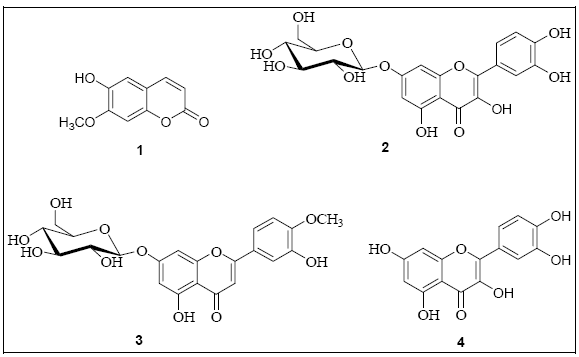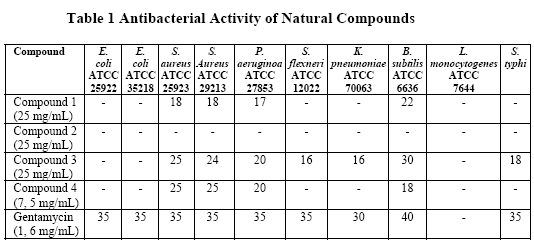Servicios Personalizados
Revista
Articulo
Indicadores
Links relacionados
Compartir
Revista Boliviana de Química
versión On-line ISSN 0250-5460
Rev. Bol. Quim v.23 n.1 La Paz 2006
ARTÍCULO ORIGINAL
ANTIBACTERIAL ACTIVITY OF FOUR NATURAL PRODUCTS FROM A BOLIVIAN HIGHLANDS PLANT
Marcela Melgarejo, * Patricia Mollinedo, José Vila Castro
Laboratory of Natural Products, Instituto de Investigaciones Químicas, Universidad Mayor de San Andrés, calle 27 y calle Andrés Bello, Cota Cota, P.O.Box 303, La Paz-Bolivia
*Corresponding author: fitoquim@megalink.com
ABSTRACT
The study was conducted to evaluate the antibacterial potential activity of four natural compounds isolated from different higher plants collected from Pazña (Oruro - Bolivia) on the Bolivian Altiplano. Antibacterial activity was evaluated against ten bacterial strains. Agar ditch diffusion method was used to study the antibacterial activity of these compounds. Three of these four compounds exhibited considerable antibacterial activity.
Key words: Highlands (altiplano), phenolic compounds, antibacterial activity and ditch-diffusion method.
INTRODUCTION
Nature has been a source of medicinal agents for thousands of years and an impressive number of modern drugs have been isolated from natural sources, many of them based on their use in traditional medicine. Medicinal plants have been used for years in daily life to treat disease all over the world1.
Plants produce a diverse range of bioactive molecules, making them an important source of medicinal compounds; playing a dominant role in the maintenance of human health since ancient times2. Over 50 % of all modern clinical drugs are natural product, and 30 % more are based on the squeleton of natural product3.Then natural products play an important role in drug development programs in the pharmaceutical industry4.
Bolivia is one of the first 15th mega-diverse countries of the world, it has 199 ecosystems and it harbours a great number of fauna species and flora. It occupies the sixth place in extension of tropical forests and the eleventh place covering forests.
The ancestral knowledge of the use of the nature has allowed its inhabitants to cure its own illnesses for many years such as gastrointestinal illnesses, however it is necessary the study of these medicinal properties in order to contribute to the scientific knowledge and improving the use of these vegetal species.
One of the illnesses with more death rate, especially in children, are the infections caused by enterobacterias another factor that is important of point out it is the resistance that these bacterias have developed. Many of the common medications do not work, then third generation antibiotics it is necessary to use, therefore the search of new alternative treatment is urgent and important of carrying out.
Traditional medicine (TRM) has contributed to human health for more than three thousand years. However, efforts to understand and document the contribution of the various forms of TRM in a comprehensive manner have been less than successful, except in a few situations. As a result, we lack sufficient sound information on the safety and efficacy of TRM and its possible true complementary role and harmonization with conventional forms of medicine5.
Plants with possible antimicrobial activity should be tested against an appropriate microbial model to confirm the activity and to ascertain the parameters associated with it. The effects of plant extracts on bacteria have been studied by a very large number of researchers in different countries around the world6-8. Few works has been done based on ethnomedicinal plants in Bolivia with biological essays. Interest in a large number of traditional natural products has increased9. It has been suggested that aqueous and ethanolic extracts from plants used in allopathic medicine are potential sources of antiviral, antitumoral and antimicrobial agents10,11.
RESULTS AND DISCUSSION
Four natural compounds isolated from different higher plants were assayed: 6-hidroxy-7-methoxycoumarin (1) isolated from Parastrephia lepidophylla; quercetin 7-О-β-D-glucopyranoside (2), isolated from Cheilanthes pruinata14-16; 5, 7, 3' -trihydroxy-4' -methoxyflavone-7-O-glucopyranoside (3), isolated from Astragalus arequipensis17 and quercetin (4), isolated from Hymenoyis robusta18.

Antibacterial activity
The antibacterial activity of the four natural compounds against Escherichia coli ATCC 25922, Escherichia coli ATCC 35218, Staphylococcus aureus ATCC 25923, Staphylococcus aureus ATCC 29213, Pseudomona aeruginosa ATCC 27853, Shigella flexneri ATCC 12022, Klebsiella pneumoniae ATCC 70063, Bacillus subtilis ATCC 6636, Listeria monocytogenes ATCC 7644 and Salmonella typhi is shown in Table 1.

Compound (1) showed inhibitory activity against Staphylococcus aureus ATCC 25923, Staphylococcus aureus ATCC 29213, Pseudomona aeruginosa ATCC 27853 and Bacillus subtilis ATCC 6636.
The compound (2) did not show any activity against any of the bacterial strains.
The compound (3) showed inhibitory activity against Staphylococcus aureus ATCC 25923, Staphylococcus aureus ATCC 29213, Pseudomona aeruginosa ATCC 27853, Shigella flexneri ATCC 12022, Klebsiella pneumoniae ATCC 70063, Bacillus subtilis ATCC 6636 and Salmonella typhi. The antibacterial activity of this compound against gram-positive and gram-negative bacteria indicates that it is compound of broad spectrum.
The compound (4) showed inhibitory activity against Staphylococcus aureus ATCC 25923, Staphylococcus aureus ATCC 29213, Pseudomona aeruginosa ATCC 27853 and Bacillus subtilis ATCC 6636.
The compound (4) showed considerably more antibacterial potent against Staphylococcus aureus ATCC 25923, Staphylococcus aureus ATCC 29213, Pseudomona aeruginosa ATCC 27853 and Bacillus subtilis ATCC 6636 than compound 3, because the concentration used was less.
EXPERIMENTAL
Microorganisms test
The microbial strains studied are Escherichia coli ATCC 25922 (sensible), Escherichia coli ATCC 35218 (resistant), Staphylococcus aureus ATCC 25923 (sensible), Staphylococcus aureus ATCC 29213 (resistant), Pseudomona aeruginosa ATCC 27853 (sensible) , Shigella flexneri ATCC 12022, Klebsiella pneumoniae ATCC 70063 (resistant), Bacillus subtilis ATCC 6636, Listeria monocytogenes ATCC 7644 and Salmonella typhi (sensible).
Antibacterial assay
Agar ditch diffusion method
Bacterial suspensions were obtained from overnight cultures in Muller Hinton Broth ( BBLTM trademark of Becton, Dickinson and Company) cultivated at 37°C for 24 h. The bacterial suspensions were adjusted to an inoculum size 108 cells/mL for inoculation of the agar plates.
After the medium (Difco Bacto Mueller Hinton Medium) was solidified in the plates, the test strain (0, 2 mL) was inoculated into the media. Care was taken to ensure proper homogenization. A ditch was made in the plates with the help of a cup-borer (13 mm). The test compound was introduced into the well and the plates were incubated at 37°C for 24 h. Microbial growth was determined by measuring the diameter of the zone of inhibition12,13.
For the in vitro studies compounds were dissolved in 200 μL of dimethyl sulfoxide (DMSO).
DMSO was taken as solvent control. Gentamycin was taken as antibacterial control.
CONCLUSIONS
Three of these four compounds exhibited considerable antibacterial activity. The most susceptible bacteria were Staphylococcus aureus ATCC 25923, Staphylococcus aureus ATCC 29213, Pseudomona aeruginosa ATCC 27853 and Bacillus subtilis ATCC 6636. The less susceptible bacteria were Shigella flexneri ATCC 12022, Klebsiella pneumoniae ATCC 70063 and Salmonella typhi. The most resistant bacteria were Escherichia coli ATCC 25922, Escherichia coli ATCC 35218 and Listeria monocytogenes ATCC 7644.
The emergence of multiple-drug-resistant strains of bacteria, the indiscriminate use of antibiotics and the increasing susceptibility of individuals with acquired immunodeficiency syndrome (AIDS) to infection from Mycobacterium induce an urgent need for development of new strategies to treat bacterial infections.
From the above results it can be concluded that these compounds have great potential as antimicrobial against microorganisms and that they can be used in the treatment of infectious diseases caused by resistant microorganisms. Such biological assays natural compounds isolated from Bolivian plants have to be studied.
Furthermore, the results of the present study of these compounds know with antibacterial activity that could serve as selective agents for the maintenance of human health and provide biochemical tools for the study other infectious diseases in our country.
ACKNOWLEDGMENTS
Technicians and Professors of the he Laboratory of Natural Products of the Instituto de Investigaciones Químicas are sincerely acknowledged.
REFERENCES
1. R. NAIR, T. KALARIYA, Sumitra CHANDA. Antibacterial Activity of Some Selected Indian Medicinal. Flora.Turkish Journal of Biology, 29, (2005), 41-47. [ Links ]
2. Farombi EO. African indigenous plants with chemotherapeutic potentials and biotechnological approach to the production of bioactive prophylactic agent. African J. Biotech 2: 662-671. 2003. [ Links ]
3. Stuffness M, Douros J. Current status of the NCI plant and animal product program, J. Nat. Prod. 45: 1-14, 1982. [ Links ]
4. Baker JT, Borris RP, Carte B et al. Natural product drug discovery and development: New perspective on onternational collaboration. J. Nat. Prod. 58: 1325-1357,2001. [ Links ]
5. Kawaguchi Yuji, Director, WHO CENTRE FOR HEALTH DEVELOPMENT INTERNATIONAL SYMPOSIUM ON TRADITIONAL MEDICINE. Better Science, Policy and Services for Health Development: 11-16.
6. Reddy PS, Jamil K, Madhusudhan P et al. Antibacterial activity of isolates from Piper nigrum and Taxus baccata. Pharmaceutical Biol. 39: 236-238, 2001. [ Links ]
7. Erdogrul OT. Antibacterial activities of some plant extracts used in folk medicine. Pharmaceutical Biol.40: 269-273, 2002. [ Links ]
8. Ates DA, Erdogrul OT. Antimicrobial activities of various medicinal and commercial plant extracts. Turk J. Biol. 27: 157-162, 2003. [ Links ]
9. Taylor RSL, Manandhar NP, Hudson JB et al. Antiviral activities of Nepalese medicinal plants. J. Ethnopharmacol 52: 157-163, 1996. [ Links ]
10. Chung TH, Kim MK et al. Investigation of Korean plant extracts for potential phytotherapeutic agents against B-virus Hepatitis. Phytotherapy Res. 9: 429-434, 1995. [ Links ]
11. Vlietinck AJ, Van Hoof L, Totté J. et al. Screening of hundred Rwandese medicinal plants for antimicrobial and antiviral properties. J. Ethnopaharmacol 46: 31-47, 1995. [ Links ]
12. Perez C, Paul M, Bazerque P. Antibiotic assay by agar ditch diffusion method. Acta Biol. Med. Exp., 15: 113-115, 1990. [ Links ]
13. Murria PR, Baron EJ, Pfaller MA, Tenover FC, Yolbe RH. Manual of Clinical Microbiology. 7th ed. Washington: ASM; 1999. p. 1527-39. [ Links ]
14. Salatino, M., Prado, J., Biochemical Systematic and Ecology 1988, 26: 761-769.
15. Kelamanson, J., Jager, A., Van Staden, J., Journal of Ethnopharmacology 2000, 69: 241-246. [ Links ]
16. Grierson, D., Afolayan, A., Journal of Ethnopharmacology 1999, 66: 103-106. [ Links ]
17. Vila Castro JL., Natural products from Bolivian plants. 2006, 20-21. [ Links ]
18. Vila Castro JL., Natural products from Bolivian plants. 2006, 31-32. [ Links ]












 uBio
uBio 

